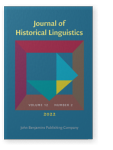Vol. 12:2 (2022) ► pp.282–316
The origin of dative subjects and psych predicate constructions in Japanese
There is considerable literature on dative subject or non-canonical subject marking constructions in Japanese, and yet they have been studied mainly from a synchronic point of view. This paper investigates the diachronic dimension of non-canonical case marking constructions in Japanese. Following Yanagida and Whitman (2009), I assume that Old Japanese (700–800 A.D.) displays split active alignment. This paper argues that dative subjects arose as a byproduct of a change occurring from active-inactive to accusative alignment. A factor triggering this change was the reanalysis of some particular object experiencer predicates as intransitives due to the loss of the vestigial causative suffix associated with the predicate. Synchronically, these constructions involve a voice alternation of the type identified as the psych causative alternation by Alexiadou and Iordăchioaia (2014): object experiencer verbs behave parallel to causative verbs whereas alternating subject experiencer verbs behave parallel to anticausative verbs.
Article outline
- 1.Introduction
- 2.The psych predicate construction in Modern Standard Japanese
- 2.1Non-canonical case marking
- 2.2Psych predicates
- 2.3The OE-SE alternation as a voice alternation
- 3.The diachrony of the psych predicate construction
- 3.1Introduction
- 3.2Alignment change: Active > accusative
- 3.3The causative alternation
- 3.4Impersonal psych transitives with an object experiencer
- 3.5The psych adjective
- 3.6Reanalysis
- 4.Conclusion
- Acknowledgements
- Notes
- Digitalized text
-
References
